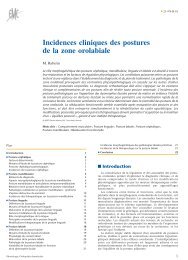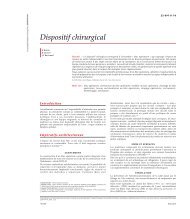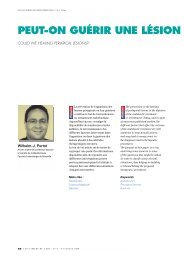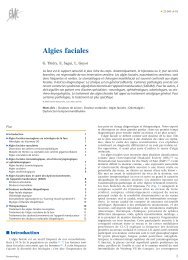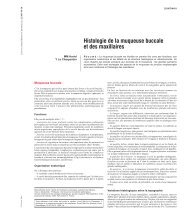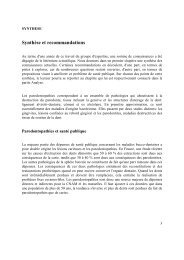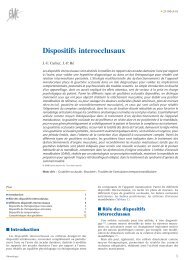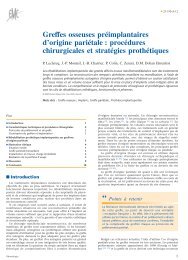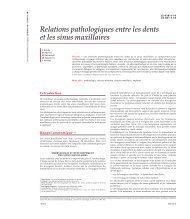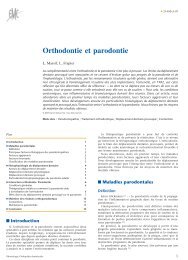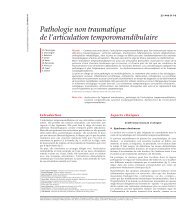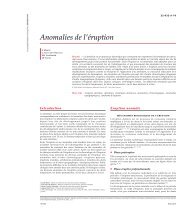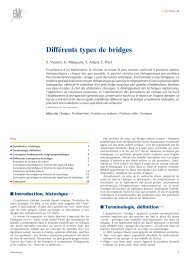Transpositions de canines. Diagnostic et traitement - Belbacha Dental
Transpositions de canines. Diagnostic et traitement - Belbacha Dental
Transpositions de canines. Diagnostic et traitement - Belbacha Dental
You also want an ePaper? Increase the reach of your titles
YUMPU automatically turns print PDFs into web optimized ePapers that Google loves.
largeur <strong>et</strong> <strong>de</strong> la profon<strong>de</strong>ur <strong>de</strong>s récessions. Le succès <strong>de</strong> recouvrement<br />
dépend <strong>de</strong> la classe <strong>de</strong> Miller <strong>et</strong> certaines techniques<br />
sont choisies en fonction <strong>de</strong> c<strong>et</strong>te classification [50] .<br />
Parmi les techniques chirurgicales <strong>de</strong> base, la greffe épithélioconjonctive<br />
<strong>de</strong> surface est supérieure aux lambeaux déplacés<br />
(latéralement <strong>et</strong> coronairement) pour gagner du tissu kératinisé<br />
en hauteur <strong>et</strong> en épaisseur, mais les lambeaux déplacés sont plus<br />
esthétiques. De plus, la quantité <strong>de</strong> recouvrement avec les<br />
greffes <strong>de</strong> tissu conjonctif est supérieure à celle observée avec les<br />
techniques chirurgicales précé<strong>de</strong>ntes (seul le lambeau positionné<br />
coronairement peut donner <strong>de</strong>s résultats comparables).<br />
Les tissus adjacents gingivaux <strong>de</strong> dimensions correctes<br />
peuvent être déplacés pour corriger les récessions. Si l’épaisseur<br />
<strong>de</strong> ce lambeau est insuffisante (inférieure à 1 mm), il est<br />
préférable d’y associer un greffon conjonctif prélevé dans<br />
l’épaisseur du palais.<br />
Des techniques sans déplacement tissulaire <strong>et</strong> avec simple<br />
greffe conjonctive peuvent aussi traiter ce type <strong>de</strong> lésions<br />
débutantes, surtout celles <strong>de</strong> classe I <strong>de</strong> Miller. Il s’agit <strong>de</strong>s<br />
techniques <strong>de</strong> Ra<strong>et</strong>zke [51] , <strong>de</strong> Bruno [52] <strong>et</strong> d’Allen [53] . Elles<br />
présentent l’avantage d’être esthétiques, peu invasives <strong>et</strong><br />
d’augmenter <strong>de</strong> manière prévisible le volume tissulaire. Enfin, la<br />
mise en place d’une membrane <strong>de</strong> régénération tissulaire guidée<br />
peut être indiquée, son avantage résidant dans l’absence <strong>de</strong><br />
prélèvement palatin [54] .<br />
■ Conclusion<br />
La transposition est un phénomène rare, qui peut s’accompagner<br />
d’anomalies <strong>de</strong>ntaires (agénésies, incisives latérales<br />
maxillaires naines...) <strong>et</strong> <strong>de</strong> résorptions radiculaires.<br />
C<strong>et</strong>te anomalie constitue, lorsqu’elle est « complète », un<br />
problème complexe.<br />
On peut penser que si l’on détecte c<strong>et</strong>te altération <strong>de</strong> la<br />
position <strong>de</strong>s <strong>de</strong>nts le plus précocement possible, on peut<br />
presque toujours la traiter, en conservant dans un premier<br />
temps la <strong>de</strong>nt transposée en position haute.<br />
Dans l’avenir, nous pourrons vraisemblablement traiter<br />
presque toutes les transpositions, même détectées tardivement,<br />
grâce :<br />
aux progrès <strong>de</strong> la parodontologie ;<br />
aux progrès <strong>de</strong> l’orthodontie ;<br />
à l’ai<strong>de</strong> <strong>de</strong>s implants à but orthodontique (minivis).<br />
Odontologie/Orthopédie <strong>de</strong>ntofaciale<br />
Figure 20.<br />
A. Interception <strong>de</strong> transposition incomplète détectée précocement.<br />
B. Correction orthodontique <strong>de</strong> la transposition.<br />
C. Cliché panoramique en fin d’interception.<br />
Cas traité par le docteur M. Rotenberg.<br />
.<br />
Il n’en reste pas moins que ce sont <strong>de</strong>s cas difficiles à traiter<br />
qui <strong>de</strong>man<strong>de</strong>ront toujours la plus gran<strong>de</strong> attention.<br />
■ Références<br />
<strong>Transpositions</strong> <strong>de</strong> <strong>canines</strong>. <strong>Diagnostic</strong> <strong>et</strong> <strong>traitement</strong> 23-492-A-12<br />
[1] Artun J, KokichVG, Osterberg SK. Long-term effect of thin inter <strong>de</strong>ntal<br />
alveolar bone on periodontal health after orthodontic treatment. Am<br />
J Orthod Dentofacial Orthop 1987;91:125-30.<br />
[2] Artun J, Osterberg SK, Kokich VG. Long-term effect of thin inter<strong>de</strong>ntal<br />
alveolar bone on periodontal health after orthodontic treatment.<br />
J Periodontol 1986;57:341-6.<br />
[3] Artun J, Ostenberg SK. Periodontal status of secondary crow<strong>de</strong>d<br />
mandibular incisors. J Clin Periodontol 1987;14:261-6.<br />
[4] Attia Y, Fayot P, Garcias D. Les <strong>canines</strong> transposées : étiologie,<br />
pathogénie. Orthod Fr 1986;57:605-27.<br />
[5] Attia Y, Fayot P. Les transpositions <strong>de</strong> <strong>canines</strong>. Traitement interceptif.<br />
Rev Orthop Dento Faciale 1987;21:251-9.<br />
[6] Miel EM. Observation sur un cas très rare <strong>de</strong> transposition <strong>de</strong> <strong>de</strong>nts.<br />
J Méd Chir Pharm 1817;40:88-97.<br />
[7] Nelson GC. Maxillary canine-third premolar transposition in a<br />
prehistoric population from Santa Cruz Island, California. Am J Phys<br />
Anthropol 1992;88:134-44.<br />
[8] Lukacs JR. Canine transposition in prehistoric Pakistan: Bronze age<br />
and iron age case reports. Angle Orthod 1998;68:475-80.<br />
[9] Brägger U, Lang NP. The significance of bone periodontal disease.<br />
Semin Orthod 1996;2:31-8.<br />
[10] Peck S, Peck L. Classification of maxillary tooth transpositions. Am<br />
J Orthod Dentofacial Orthop 1995;107:505-17.<br />
[11] Perezt B, Arad A. Bilateral transposition of maxillary canine and first<br />
premolars: case report. Quintessence Int 1992;23:345-8.<br />
[12] Chattopadhyay A, Srinivas K. Transposition of the te<strong>et</strong>h and gen<strong>et</strong>ic<br />
<strong>et</strong>iology. Angle Orthod 1996;66:147-52.<br />
[13] Plunk<strong>et</strong>t DJ, Dysart PS, Kardos TB, Herbison GP.Astudy of transposed<br />
canine in a sample of orthodontic patients. Br J Orthod 1998;25:203-8.<br />
[14] RuprechtA, Batniji S, El-Neweihi E. The inci<strong>de</strong>nce of the transposition<br />
of te<strong>et</strong>h in <strong>de</strong>ntal patients. J Pedod 1985;9:244-9.<br />
[15] Sandham A, Harvie H. Ectopic eruption of the maxillary canine<br />
resulting in transposition with adjacent te<strong>et</strong>h. Tandlaegebla<strong>de</strong>t 1985;<br />
89:9-11.<br />
[16] Järvinen S. Mandibular incisor-cuspid transposition: a survey. J Pedod<br />
1982;6:159-63.<br />
13



